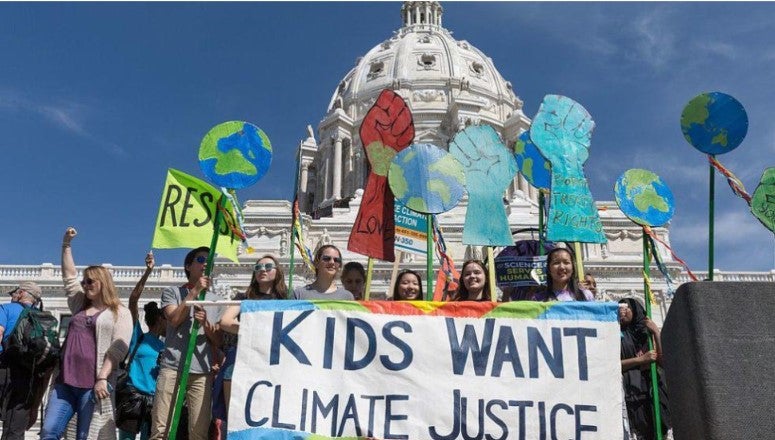Empowering Children with Disabilities Against Climate Change

Posted in Disability | Tagged International
by Dylan Antonioli, Ryan Enangelista, Lauren Gaetano, Ollie Henry, Kayla Kinkead, Tsering Lama
What does climate change look like through the disability lens; for children with disabilities? Climate change has been a dominant topic due to the increasing incidence of natural disasters, harmful exposure to greenhouse gasses, and the significant threat to humankind. Climate change is driven by fossil fuel combustion used to produce energy, leading to the increase in Earth’s average surface temperature or what we often regard as global warming. Global warming is catastrophic and can lead to natural disasters. When exploring climate change through the disability lens, it is fundamental to understand factors contributing to vulnerability and adaptive capacity of people with disabilities (Gaskin et al., 2017).
One of the most vulnerable populations affected by climate change is children with disabilities. Fetuses, infants, and children are vulnerable because of their unique health requirements such as immature biological defense mechanisms and immune protection, need for more food and water, narrow airways and demand for more oxygen relative to body weight, compromised thermoregulatory function, and vulnerability to psychological trauma (Perera & Nadeau, 2022). For instance, people with spinal cord injury (SCI) are disproportionately affected by climate change due to their thermoregulatory dysfunction and mobility concerns (Alexander et al., 2019).
In addition to understanding the impact of climate change on children with disabilities, we must consider this issue in the context of advocacy and education. According to the Children and Youth Environmental Action: The Case of Children and Youth with Disabilities study, academic literature rarely mentions the intersection of children with disabilities and climate change. It is shocking because advocacy and activism are prominent components in combating climate change. When climate change and children with disabilities were mentioned together, there was an emphasis on how climate change worsens the ‘impairments,’ completely failing to mention activism. This focus highlights how society approaches disability through the medical rather than the social model (Bell et al., 2019). A shift to the social model will foster a great degree of activism on the part of young people with disabilities and for them. We must include children with disabilities in climate change advocacy because they are the most knowledgeable about their needs and current social situation (Salvatore & Wolbring, 2021).
The classroom setting is a critical time in which children, with and without disabilities, can understand climate change and become early advocates for greener practices. Reinforcing these ideas in classrooms and encouraging participation is an inclusive way to address this issue. It is essential that teachers receive the appropriate training, resources, and support, however, to successfully encourage all their students to be stewards of the Earth and advocates outside of the classroom; this is where policy-makers enter the picture. Children with disabilities must have the opportunity to participate in advocacy because ultimately, it influences policy (Leong, 2020). Changing the narrative about climate change and making sure that children with disabilities have an opportunity to actively participate allows significant change to occur from an environmental, educational, and disability justice perspective. Empowering children with disabilities to join the “fight” is crucial to combat climate change (Salvatore & Wolbring, 2021) in a way that benefits all.
References
Alexander, M., Alexander, J., Arora, M., Slocum, C., & Middleton, J. (2019). A bellweather for climate change and disability: educational needs of rehabilitation professionals regarding disaster management and spinal cord injuries. Spinal cord series and cases, 5(1), 94.
Bell, S. L., Tabe, T., & Bell, S. (2020). Seeking a disability lens within climate change migration discourses, policies and practices. Disability & society, 35(4), 682-687.
Gaskin, C. J., Taylor, D., Kinnear, S., Mann, J., Hillman, W., & Moran, M. (2017). Factors associated with the climate change vulnerability and the adaptive capacity of people with disability: a systematic review. Weather, Climate, and Society, 9(4), 801-814.
Kids Take a Stand Against Climate Change, but Do They Have Standing? (n.d.). Georgetown Environmental Law Review | Georgetown Law. https://www.law.georgetown.edu/environmental-law-review/blog/kids-take-a-stand-against-climate-change-but-do-they-have-standing/
Moore, A., Lynch, H., & Boyle, B. (2022). Can universal design support outdoor play, social participation, and inclusion in public playgrounds? A scoping review. Disability and Rehabilitation, 44(13), 3304-3325.
Perera, F., & Nadeau, K. (2022). Climate change, fossil-fuel pollution, and children’s health.
New England Journal of Medicine, 386(24), 2303-2314.
Salvatore, C., & Wolbring, G. (2021). Children and youth environmental action: The case of children and youth with disabilities. Sustainability, 13(17), 9950.
